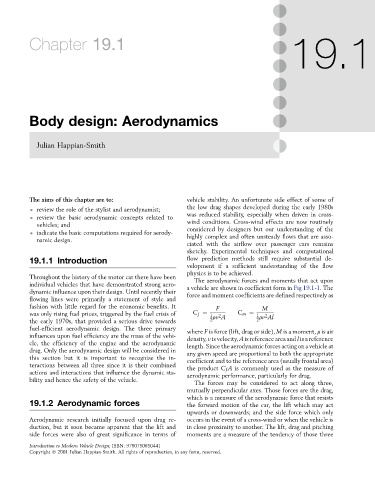Page 653 - Automotive Engineering Powertrain Chassis System and Vehicle Body
P. 653
19.1
Chapter 19.1
Body design: Aerodynamics
Julian Happian-Smith
The aims of this chapter are to: vehicle stability. An unfortunate side effect of some of
review the role of the stylist and aerodynamist; the low drag shapes developed during the early 1980s
review the basic aerodynamic concepts related to was reduced stability, especially when driven in cross-
vehicles; and wind conditions. Cross-wind effects are now routinely
indicate the basic computations required for aerody- considered by designers but our understanding of the
highly complex and often unsteady flows that are asso-
namic design.
ciated with the airflow over passenger cars remains
sketchy. Experimental techniques and computational
19.1.1 Introduction flow prediction methods still require substantial de-
velopment if a sufficient understanding of the flow
physics is to be achieved.
Throughout the history of the motor car there have been The aerodynamic forces and moments that act upon
individual vehicles that have demonstrated strong aero- a vehicle are shown in coefficient form in Fig 19.1-1. The
dynamic influence upon their design. Until recently their force and moment coefficients are defined respectively as
flowing lines were primarily a statement of style and
fashion with little regard for the economic benefits. It F M
was only rising fuel prices, triggered by the fuel crisis of C ¼ 1 rv A C m ¼ 1 rv Al
f
2
2
the early 1970s, that provided a serious drive towards 2 2
fuel-efficient aerodynamic design. The three primary
where F is force (lift, drag or side), M is a moment, r is air
influences upon fuel efficiency are the mass of the vehi-
density, v is velocity, A is reference area and l is a reference
cle, the efficiency of the engine and the aerodynamic
length. Since the aerodynamic forces acting on a vehicle at
drag. Only the aerodynamic design will be considered in
any given speed are proportional to both the appropriate
this section but it is important to recognize the in- coefficient and to the reference area (usually frontal area)
teractions between all three since it is their combined the product C f A is commonly used as the measure of
actions and interactions that influence the dynamic sta- aerodynamic performance, particularly for drag.
bility and hence the safety of the vehicle.
The forces may be considered to act along three,
mutually perpendicular axes. Those forces are the drag,
which is a measure of the aerodynamic force that resists
19.1.2 Aerodynamic forces the forward motion of the car, the lift which may act
upwards or downwards; and the side force which only
Aerodynamic research initially focused upon drag re- occurs in the event of a cross-wind or when the vehicle is
duction, but it soon became apparent that the lift and in close proximity to another. The lift, drag and pitching
side forces were also of great significance in terms of moments are a measure of the tendency of those three
Introduction to Modern Vehicle Design; ISBN: 9780750650441
Copyright Ó 2001 Julian Happian-Smith. All rights of reproduction, in any form, reserved.

